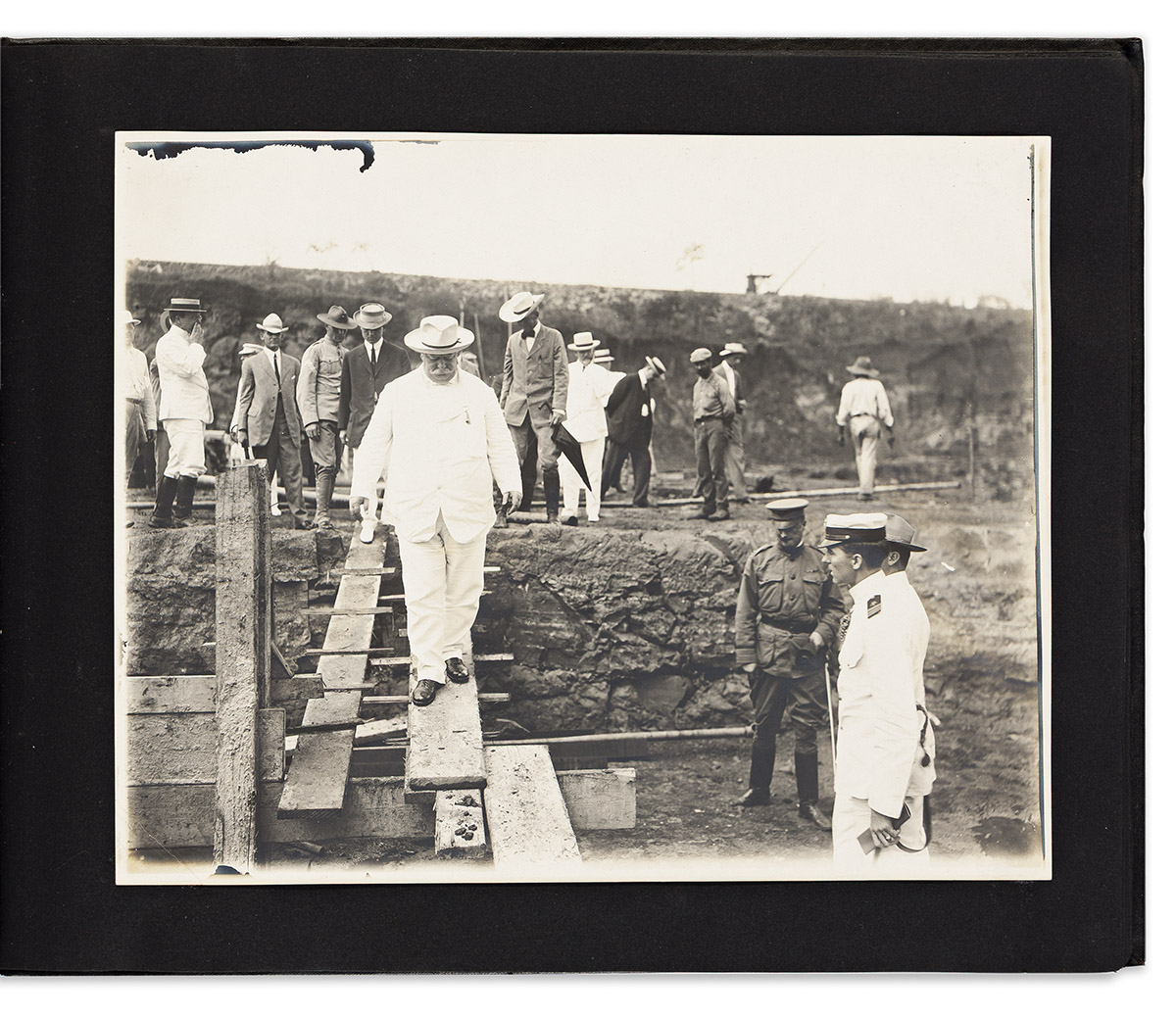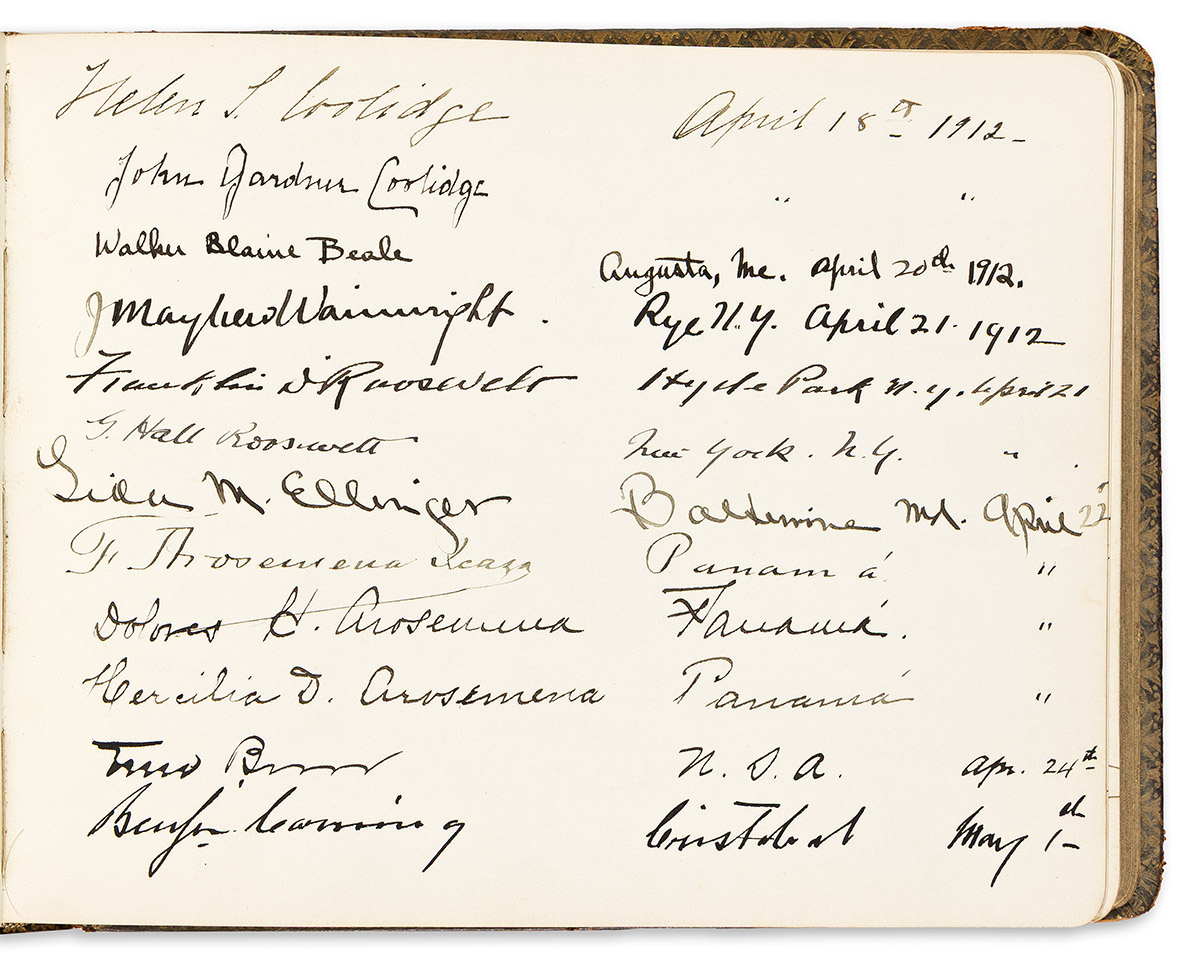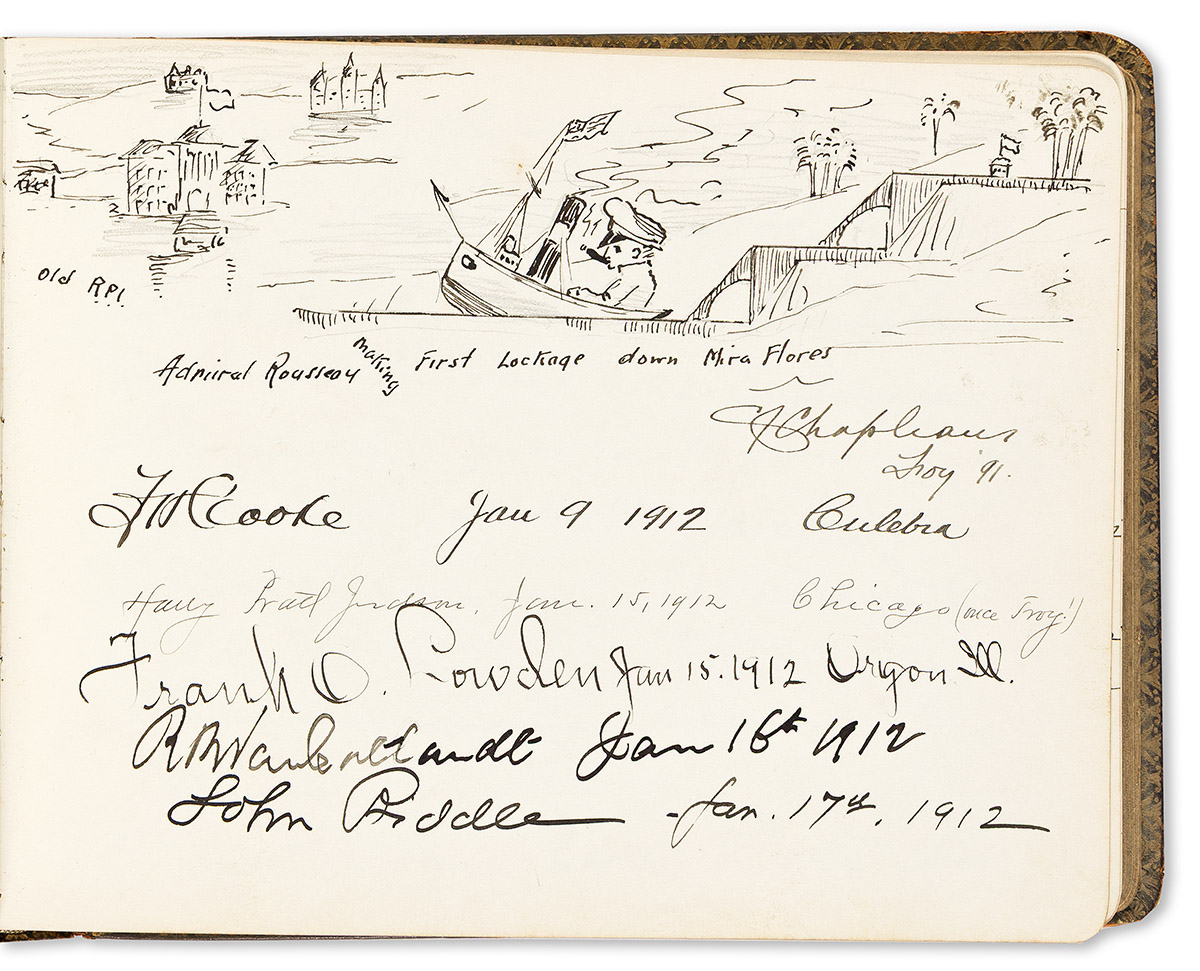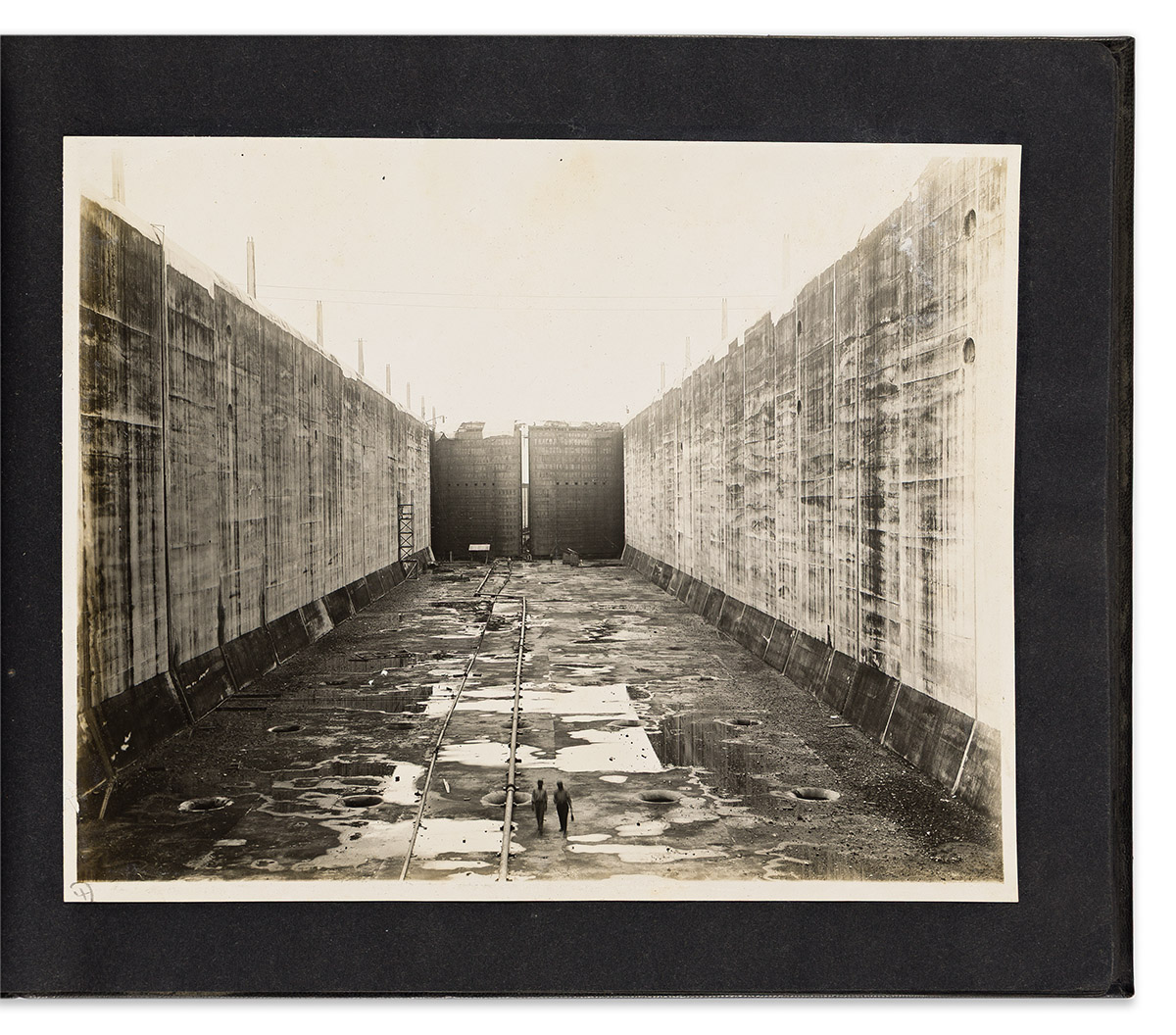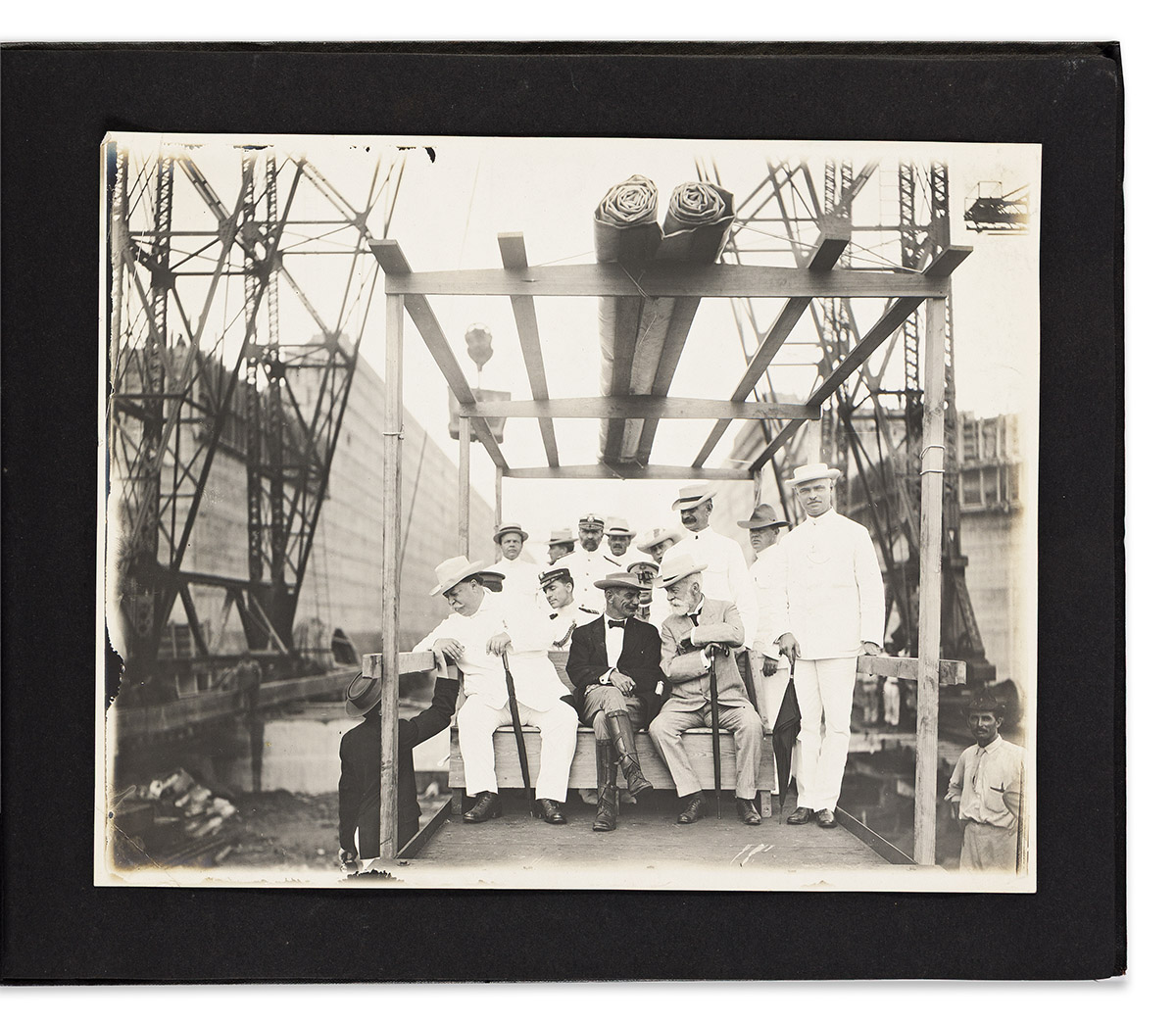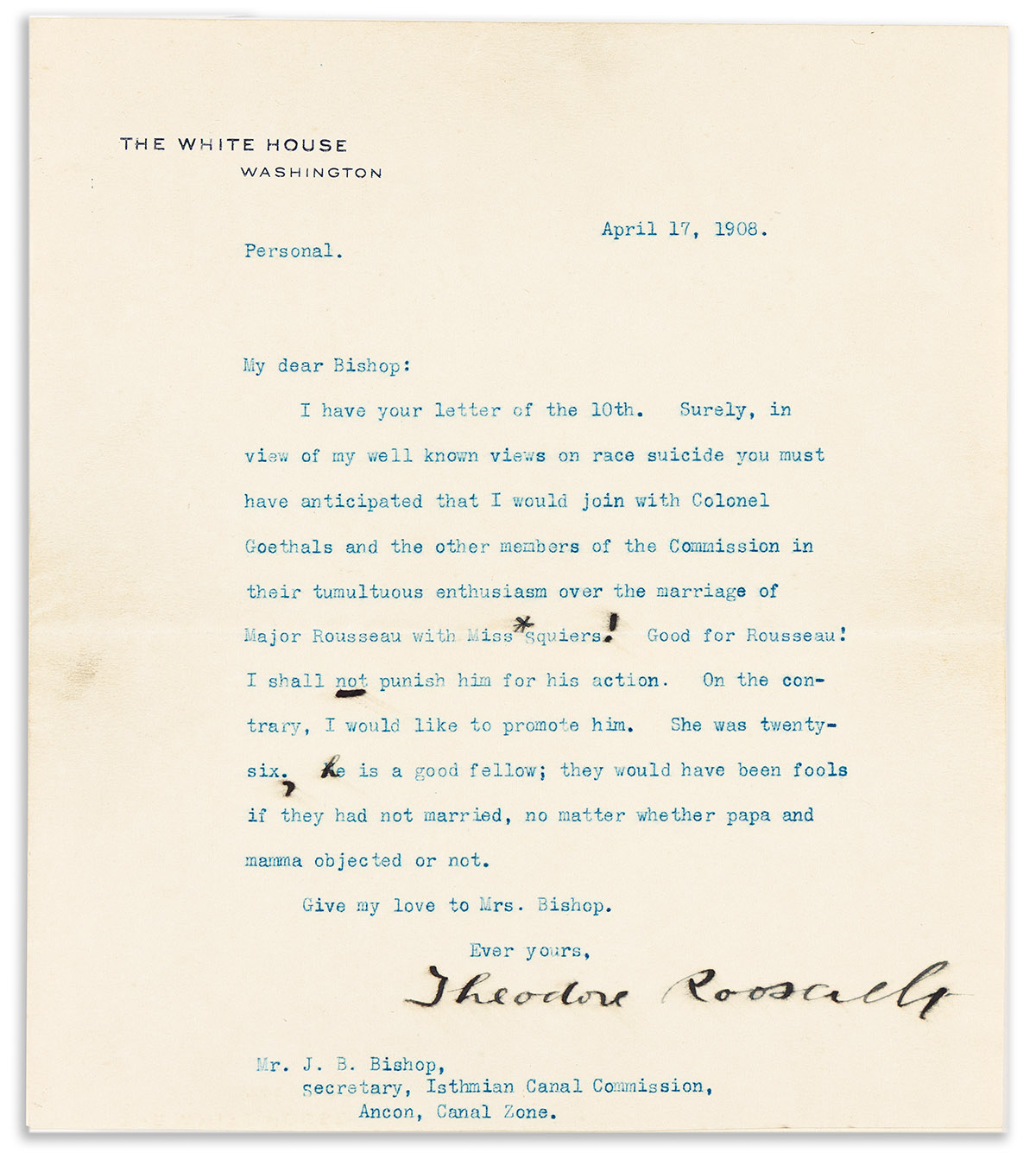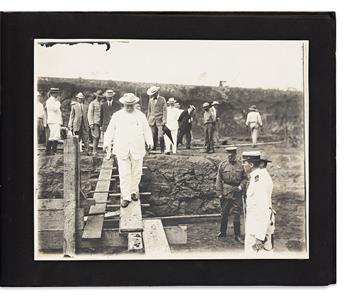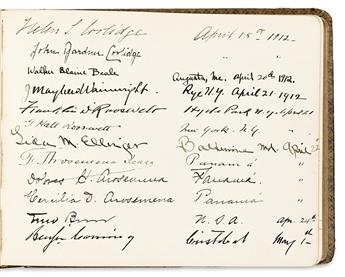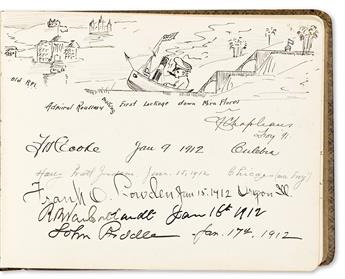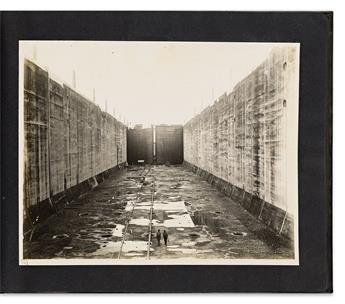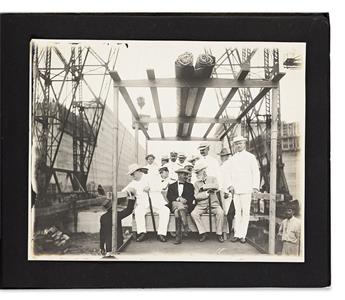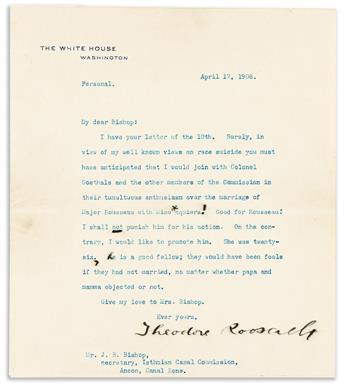Sale 2708 - Lot 101
Price Realized: $ 13,000
Price Realized: $ 16,250
?Final Price Realized includes Buyer’s Premium added to Hammer Price
Estimate: $ 4,000 - $ 6,000
(FAMILY PAPERS.) Papers of naval engineer Harry H. Rousseau, an important force in the construction of the Panama Canal. Thousands of items in 5 boxes plus one sleeve (5 linear feet), including photographs, albums, correspondence, printed ephemera, and artifacts; condition varies, generally minor wear. Various places, bulk 1898-1930
Additional Details
Harry Harwood Rousseau (1870-1939) was raised in Troy, NY and attended the Rensselaer Institute of Technology before embarking on a distinguished career as a Navy engineer. He was appointed to the Isthmian Canal Commission in 1904 under Panama Canal chief engineer George W. Goethals, and in 1911 was placed in charge of construction of the canal's terminals. In 1915, Rousseau was promoted to Rear Admiral for his central role in the completion of the canal--the youngest man who had ever achieved that rank in the navy's history. Although he returned to the United States, he remained associated with the canal and the Panama Railroad for the remainder of his career.
A set of 6 photo albums cover Rousseau's personal and professional life from around the time of his involvement with the canal, mostly 1907-1916. Then-Secretary of War William H. Taft makes several appearances in the first album, from his April 1907 visit to the Canal Zone. In one, a white-suited Taft can be seen gingerly making his way across a plank at a muddy excavation site. Goethals can also be seen in many of the photographs. Rousseau's correspondence includes folders of Canal-related letters, including 12 long and personal letters from his mentor Goethals. Also included are reports and other canal-related papers, including his typescript carbon report "The Terminal Facilities of the Panama Canal," 34 pages, circa 1916. Other engineering papers date from his time at California's Mare Island naval base, 1903-1907.
Among the small number of loose photos, one shows a group in Hollywood with Rousseau, actor Douglas Fairbanks and others. Another circa the 1940s shows family members visiting the bus station at Rousseau, Panama, which was named after the Rear Admiral. A worn and stained cabinet card photograph of Taft and Goethals is signed by both.
Rousseau's interesting personal life is also well documented here. In 1908, he married Gladys Fargo Squiers (1882-1974), daughter of the American minister to Panama, Herbert Squiers (see the preceding lot) and granddaughter of shipping mogul William G. Fargo (see the lot before that). The courtship was against the father's wishes. Included are many of their secret letters, as well as a stern letter from Squiers dated 27 December 1907: "Regarding your proposal of marriage with my daughter, I beg to advise you that I have agreed with her that she is not to communicate with you directly or indirectly during the period of time ending Jan. 1 1911. . . . I trust you will do nothing to cause Gladys to violate her agreement with me." Harry replied on 7 February 1908: "Whatever I do shall be from consideration of Gladys' wishes." On 4 April 1908, Harry and Gladys were both invited to the same society event at a Panama hotel, and snuck off to be married before a justice on the second floor. This surprise elopement was a national news story. The full-page illustrated spread in the New York World Magazine of 10 May 1908, encapsulated in mylar, is included here. It also brought a warm 17 April 1908 letter of congratulations from President Theodore Roosevelt to Rousseau's boss J.B. Bishop, secretary of the Canal Commission (with a reference to his controversial "race suicide" theory):
"Surely, in view of my well known views on race suicide you must have anticipated that I would join with Colonel Goethals and the other members of the Commission in their tumultuous enthusiasm over the marriage of Major Rousseau with Miss Squiers! Good for Rousseau! I shall not punish him for his action. On the contrary, I would like to promote him. She was twenty-six, he is a good fellow; they would have been fools if they had not married, no matter whether papa and mamma objected or not."
The collection includes 4 scrapbooks, 1898-1916, most of them from Rousseau's time as a young naval officer and eligible bachelor through 1907 in Washington and California; they include countless invitations, calling cards, and other ephemera of social engagements: several White House invitations, cards from various Roosevelts, Alexander Graham Bell, Madame Bonaparte, and much more. The final scrapbook covers his departure from Panama, with a letter from his servant Robert Isaacs, 31 May 1916: "I think it right to express to you my acknowledgment of your past kindnesses. Candidly speaking, there are but few men of your grade who ever think of a coloured man, much less to be interested in him." A letter from Goethals releases Rousseau at the end of his service, 20 May 1916.
A family guest book covers 1909-1922, mostly kept in Panama, with scattered later entries. It includes hundreds of signatures, including young Franklin Delano Roosevelt, then a New York state senator, who visited on 21 April 1912.
Rousseau also played a role in cleaning up the Teapot Dome scandal, in which President Harding's Secretary of the Interior was jailed for selling off leases for the naval petroleum reserve. Included is a small diary from January 1928, in which Rousseau visits Casper, Wyoming to investigate the Mammoth Oil Company and the petroleum reserve. 7 folders relate to the Ottoman-American Development Corporation, 1922-1923, a controversial oil contract with Turkey.
Artifacts include his naval insignia and gaiters, as well as a "Ships for Victory" medal presented to Rousseau by Charles Schwab.
This collection is not only an important resource on the construction of the Panama Canal, it also has more than the usual interest as a family archive. A more detailed inventory of this large and wide-ranging collection is available upon request.
A set of 6 photo albums cover Rousseau's personal and professional life from around the time of his involvement with the canal, mostly 1907-1916. Then-Secretary of War William H. Taft makes several appearances in the first album, from his April 1907 visit to the Canal Zone. In one, a white-suited Taft can be seen gingerly making his way across a plank at a muddy excavation site. Goethals can also be seen in many of the photographs. Rousseau's correspondence includes folders of Canal-related letters, including 12 long and personal letters from his mentor Goethals. Also included are reports and other canal-related papers, including his typescript carbon report "The Terminal Facilities of the Panama Canal," 34 pages, circa 1916. Other engineering papers date from his time at California's Mare Island naval base, 1903-1907.
Among the small number of loose photos, one shows a group in Hollywood with Rousseau, actor Douglas Fairbanks and others. Another circa the 1940s shows family members visiting the bus station at Rousseau, Panama, which was named after the Rear Admiral. A worn and stained cabinet card photograph of Taft and Goethals is signed by both.
Rousseau's interesting personal life is also well documented here. In 1908, he married Gladys Fargo Squiers (1882-1974), daughter of the American minister to Panama, Herbert Squiers (see the preceding lot) and granddaughter of shipping mogul William G. Fargo (see the lot before that). The courtship was against the father's wishes. Included are many of their secret letters, as well as a stern letter from Squiers dated 27 December 1907: "Regarding your proposal of marriage with my daughter, I beg to advise you that I have agreed with her that she is not to communicate with you directly or indirectly during the period of time ending Jan. 1 1911. . . . I trust you will do nothing to cause Gladys to violate her agreement with me." Harry replied on 7 February 1908: "Whatever I do shall be from consideration of Gladys' wishes." On 4 April 1908, Harry and Gladys were both invited to the same society event at a Panama hotel, and snuck off to be married before a justice on the second floor. This surprise elopement was a national news story. The full-page illustrated spread in the New York World Magazine of 10 May 1908, encapsulated in mylar, is included here. It also brought a warm 17 April 1908 letter of congratulations from President Theodore Roosevelt to Rousseau's boss J.B. Bishop, secretary of the Canal Commission (with a reference to his controversial "race suicide" theory):
"Surely, in view of my well known views on race suicide you must have anticipated that I would join with Colonel Goethals and the other members of the Commission in their tumultuous enthusiasm over the marriage of Major Rousseau with Miss Squiers! Good for Rousseau! I shall not punish him for his action. On the contrary, I would like to promote him. She was twenty-six, he is a good fellow; they would have been fools if they had not married, no matter whether papa and mamma objected or not."
The collection includes 4 scrapbooks, 1898-1916, most of them from Rousseau's time as a young naval officer and eligible bachelor through 1907 in Washington and California; they include countless invitations, calling cards, and other ephemera of social engagements: several White House invitations, cards from various Roosevelts, Alexander Graham Bell, Madame Bonaparte, and much more. The final scrapbook covers his departure from Panama, with a letter from his servant Robert Isaacs, 31 May 1916: "I think it right to express to you my acknowledgment of your past kindnesses. Candidly speaking, there are but few men of your grade who ever think of a coloured man, much less to be interested in him." A letter from Goethals releases Rousseau at the end of his service, 20 May 1916.
A family guest book covers 1909-1922, mostly kept in Panama, with scattered later entries. It includes hundreds of signatures, including young Franklin Delano Roosevelt, then a New York state senator, who visited on 21 April 1912.
Rousseau also played a role in cleaning up the Teapot Dome scandal, in which President Harding's Secretary of the Interior was jailed for selling off leases for the naval petroleum reserve. Included is a small diary from January 1928, in which Rousseau visits Casper, Wyoming to investigate the Mammoth Oil Company and the petroleum reserve. 7 folders relate to the Ottoman-American Development Corporation, 1922-1923, a controversial oil contract with Turkey.
Artifacts include his naval insignia and gaiters, as well as a "Ships for Victory" medal presented to Rousseau by Charles Schwab.
This collection is not only an important resource on the construction of the Panama Canal, it also has more than the usual interest as a family archive. A more detailed inventory of this large and wide-ranging collection is available upon request.
Exhibition Hours
Exhibition Hours
Aliquam vulputate ornare congue. Vestibulum maximus, libero in placerat faucibus, risus nisl molestie massa, ut maximus metus lectus vel lorem.



